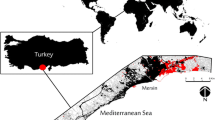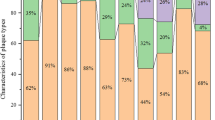Abstract
Obtaining information about the spatial distribution of desert plants is considered as a serious challenge for ecologists and environmental modeling due to the required intensive field work and infrastructures in harsh and remote arid environments. A new method was applied for assessing the spatial distribution of the halophytic species (HS) in an arid coastal environment. This method was based on the object-based image analysis for a high-resolution Google Earth satellite image. The integration of the image processing techniques and field work provided accurate information about the spatial distribution of HS. The extracted objects were based on assumptions that explained the plant-pixel relationship. Three different types of digital image processing techniques were implemented and validated to obtain an accurate HS spatial distribution. A total of 2703 individuals of the HS community were found in the case study, and approximately 82 % were located above an elevation of 2 m. The micro-topography exhibited a significant negative relationship with pH and EC (r = −0.79 and −0.81, respectively, p < 0.001). The spatial structure was modeled using stochastic point processes, in particular a hybrid family of Gibbs processes. A new model is proposed that uses a hard-core structure at very short distances, together with a cluster structure in short-to-medium distances and a Poisson structure for larger distances. This model was found to fit the data perfectly well.













Similar content being viewed by others
References
Abd El-Kawy, O. R., Rød, J. K., Ismail, H. A., & Suliman, A. S. (2011). Land use and land cover change detection in the western Nile delta of Egypt using remote sensing data. Applied Geography, 31(2), 483–494.
Akaike, H. (1973). Information theory and an extension of the maximum likelihood principle. In B. N. Petrov & F. Csaki (Eds.), Second international symposium on information theory (pp. 267–281). Budapest: Academia Kiado.
Baddeley, A., & Tuner, R. (2000). Practical maximum pseudolikelihood for spatial point patterns. Australian and New Zealand Journal of Statistics, 42, 283–322.
Baddeley, A. J., & Turner, R. (2006). Modelling spatial point patterns in r in case studies in spatial point process modelling. USA: Springer.
Baddeley, A., Moller, J., & Waagepetersen, R. (2000). Non- and semiparametric estimation of interaction in inhomogeneous point patterns. Statistica Neerlandica, 54, 329–350.
Baddeley, A., Turner, R., Mateu, J., & Bevan, A. H. (2013). Hybrids of Gibbs point process models and their implementation. Journal of Statistical Software, 55(11), 1–43.
Badreldin, N., & Goossens, R. (2013a). Monitoring land use/land cover change using multi-temporal Landsat satellite images in an arid environment: a case study of El-Arish, Egypt. Arabian Journal of Geosciences. doi:10.1007/s12517-013-0916-3ui.
Badreldin, N., & Goossens, R. (2013b). A satellite-based disturbance index algorithm for monitoring mitigation strategies effects on desertification change in an arid environment. Mitigation and Adaptation Strategies for Global Change. doi:10.1007/s11027-013-9490-y.
Berman, M., & Turner, T. R. (1992). Approximating point process likelihoods with GLIM. Journal of the Royal Statistical Society, 41, 31–38.
Bertness, M. D., & Callaway, R. (1994). Positive interactions in communities. Trends in Ecology & Evolution, 9, 191–193.
Blanco-Canqui, H., & Lal, R. (2010). Principles of soil conservation and management. Dordrecht: Springer. doi:10.1007/978-1-4020-8709-7.
Blaschke, T. (2010). Object based image analysis for remote sensing. ISPRS Journal of Photogrammetry and Remote Sensing, 65(1), 2–16.
Coppin, P., Jonckheere, I., Nackaerts, K., Muys, B., & Lambin, E. (2004). Digital change detection methods in ecosystem monitoring: a review. International Journal of Remote Sensing, 25(9), 1565–1596.
Dale, M. R. T. (1999). Spatial pattern analysis in plant ecology (p. 337). Cambridge: Cambridge University Press.
Delicado, P., Giraldo, R., Comas, C., & Mateu, J. (2010). Statistics for spatial functional data: some recent contributions. Environmetrics, 21, 224–239.
Diggle, P. J. (2003). Statistical analysis of spatial point patterns (2nd ed.). London: Edward Arnold.
El-Bana, M., Khedr, A., Van Hecke, P., & Bogaert, J. (2002). Vegetation composition of a threatened hypersaline lake (Lake Bardawil), North Sinai. Plant Ecology, 1937, 63–75.
El-Bana, M. I., Li, Z. Q., & Nijs, I. (2007). Role of host identity in effects of phytogenic mounds on plant assemblages and species richness on coastal arid dunes. Journal of Vegetation Science, 18, 635–644.
Fortin, M.-J., & Dale, M. (2009). Spatial autocorrelation in ecological studies: a legacy of solutions and myths. Geographical Analysis, 41, 392–397.
Frankl, A., Zwertvaegher, A., Poesen, J., & Nyssen, J. (2013). Transferring Google Earth observations to GIS-software: example from gully erosion study. International Journal of Digital Earth, 6(2), 196–201.
Galiano, E. F. (1985). The small-scale pattern of Cynodon dactylon in Mediterranean pastures. Vegetatio, 63(3), 121–127.
Geyer, C. J. (1999). Likelihood inference for spatial point processes. In O. E. Barndorff-Nielsen, W. S. Kendall, & M. N. M. van Lieshout (Eds.), Stochastic geometry: likelihood and computation (pp. 79–140). London: Chapman and Hall/CRC.
Goossens, R., & Van Ranst, E. (1998). The use of remote sensing to map gypsiferous soils in the Ismailia Province (Egypt). Geoderma, 87(1–2), 47–56.
Greenwood, N. H. (1997). The Sinai: a physical geography (p. 148). Austin: University of Texas Press.
Greig-Smith, P. (1961). Data on pattern within plant communities: I. The analysis of pattern. Journal of Ecology, 49(3), 695–702.
Illian, J., Penttinen, A., Stoyan, H., & Stoyan, D. (2008). Statistical analysis and modelling of spatial point patterns (p. 557). Chichester: Wiley.
Kershaw, K. A. (1959). An investigation of the structure of a grassland community: II. The pattern of Dactylis glomerata. Lolium Perenne and Trifolium Repens: III. Discussion and conclusions. Journal of Ecology, 47(1), 31–53.
Knorn, J., Rabe, A., Radeloff, V. C., Kuemmerle, T., Kozak, J., & Hostert, P. (2009). Land cover mapping of large areas using chain classification of neighboring Landsat satellite images. Remote Sensing of Environment, 113(5), 957–964.
Kottek, M., Grieser, J., Beck, C., Rudolf, B., & Rubel, F. (2006). World Map of the Köppen-Geiger climate classification updated. Meteorologische Zeitschrift, 15(3), 259–263.
Liu, J. G., & Mason, P. J. (2009). Essential image processing and GIS for remote sensing (p. 462). Chichester: Wiley.
Møller, J., & Waagepetersen, R. (2003). Statistical inference and simulation for spatial point processes. Chapman and Hall/CRC Press.
Natural Resources Conservation Service (NRCS). (1999). Soil taxonomy: a basic system of soil classification for making and interpreting soil surveys (Second Edi., p. 871). Washington, DC: United States Department of Agriculture (USDA).
Naz, N., Hameed, M., Ahmad, S. A., Ashraf, M., & Arshad, M. (2010). Is soil salinity one of the major determinants of community structure under arid environments? Community Ecology, 11, 84–90.
Pan, D., Bouchard, A., Legendre, P., & Domon, G. (1998). Influence of edaphic factors on the spatial structure of inland halophytic communities: a case study in China. Journal of Vegetation Science, 9, 797–804.
Peel, M. C., Finlayson, B. L., & Mcmahon, T. A. (2007). Updated world map of the Köppen-Geiger climate classification. Hydrology and Earth System Sciences, 11, 1633–1644.
Perry, G. L. W., Miller, B. P., & Enright, N. J. (2006). A comparison of methods for the statistical analysis of spatial point patterns in plant ecology. Plant Ecololgy, 187, 59–82.
Petrou, M., & Bosdogianni, P. (1999). Image processing: the fundamentals (p. 347). Chichester: Wiley.
Quets, J., Temmerman, S., El-Bana, M. I., Al-Rowaily, S., Assaeed, A. M., & Nijs, I. (2013). Unravelling landscapes with phytogenic mounds (nebkhas): an exploration of spatial pattern. Acta Oecologica, 49, 53–63.
Rhoades, J. D. (1992). Instrumental field methods of salinity appraisal. Advances in measurement of soil physical properties: bringing theory into practice (Vol. SSSA, pp. 231–248). Soil Science Society of America.
Rubio-Casal, A. E., Castillo, J. M., Luque, C. J., & Figueroa, M. E. (2001). Nucleation and facilitation in salt pans in Mediterranean salt marshes. Journal of Vegetation Science, 12(6), 761–770.
Sadr, K., & Rodier, X. (2012). Google Earth, GIS and stone-walled structures in southern Gauteng, South Africa. Journal of Archaeological Science, 39(4), 1034–1042.
U.S. Salinity Laboratory. (1954). Diagnosis and improvement of saline and alkali soils (Handbook 6) (p. 172). Washington, DC: U.S. Government Printing Office.
Schowengerdt, R. A. (2007). Remote sensing: models and methods for image processing (3rd ed., p. 558). Amsterdam: Elsevier.
Shalaby, A., & Tateishi, R. (2007). Remote sensing and GIS for mapping and monitoring land cover and land-use changes in the Northwestern coastal zone of Egypt. Applied Geography, 27(1), 28–41.
Sheppard, S. R. J., & Cizek, P. (2009). The ethics of Google Earth: crossing thresholds from spatial data to landscape visualisation. Journal of Environmental Management, 90(6), 2102–2117.
Shih, F. Y. (2010). Image processing and pattern recognition: fundamentals and techniques (p. 552). Hoboken: Wiley.
Taylor, J. R., & Lovell, S. T. (2012). Mapping public and private spaces of urban agriculture in Chicago through the analysis of high-resolution aerial images in Google Earth. Landscape and Urban Planning, 108(1), 57–70.
Ungar, I. A., Benner, D. K., & McGraw, D. C. (1977). The distribution and growth of Salicornia europaea on an inland salt pan. Ecology, 60(2), 329–336.
Usher, M. B. (1983). Pattern in the simple moss-turf communities of the Sub-Antarctic and Maritime Antarctic. Journal of Ecology, 71(3), 945–958.
Vincent, L., & Soille, P. (1991). Watersheds in digital spaces: an efficient algorithm based on immersion simulations. IEEE Transactions on Pattern Analysis and Machine Intelligence, 13(6), 583–598.
Webster, R., & Oliver, M. A. (2007). Geostatistics for environmental scientists (2nd ed., p. 333). Chichester: Wiley.
Winkler, G. (2006). Image analysis, random fields and Markov chain Monte Carlo methods: a mathematical introduction (stochastic modelling and applied probability). Retrieved from http://dl.acm.org/citation.cfm?id=1206577.
Yang, X., Jiang, G.-M., Luo, X., & Zheng, Z. (2012). Preliminary mapping of high-resolution rural population distribution based on imagery from Google Earth: a case study in the Lake Tai basin, eastern China. Applied Geography, 32(2), 221–227.
Acknowledgments
Part of this research was supported by Agricultural Research and Development Fund (ARDF) in Egypt, and J.U-D. was partly funded by German Research Foundation (DFG) research training group “Scaling problems in statistics” (RTG 1644). We gratefully acknowledge Google Earth for providing high-resolution satellite data. Also, we thank the anonymous reviewers for their criticism.
Author information
Authors and Affiliations
Corresponding author
Rights and permissions
About this article
Cite this article
Badreldin, N., Uria-Diez, J., Mateu, J. et al. A spatial pattern analysis of the halophytic species distribution in an arid coastal environment. Environ Monit Assess 187, 224 (2015). https://doi.org/10.1007/s10661-015-4403-z
Received:
Accepted:
Published:
DOI: https://doi.org/10.1007/s10661-015-4403-z




